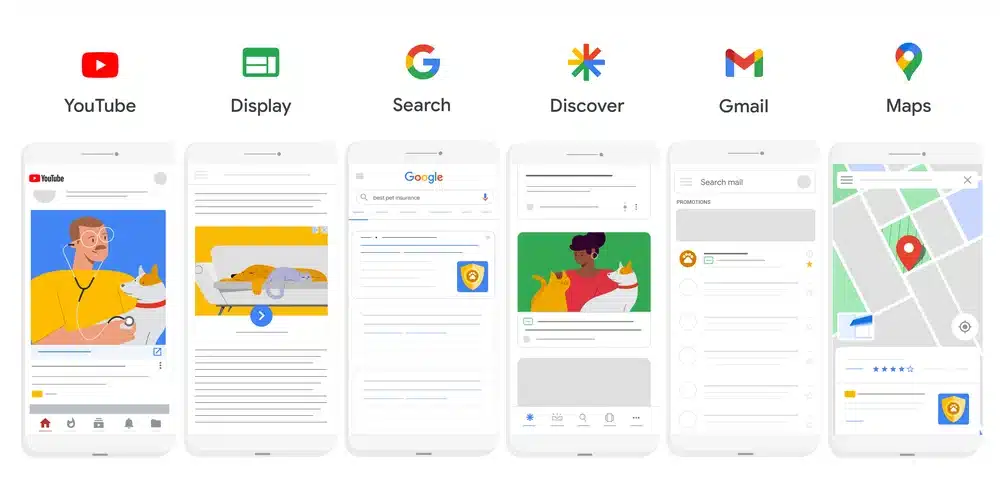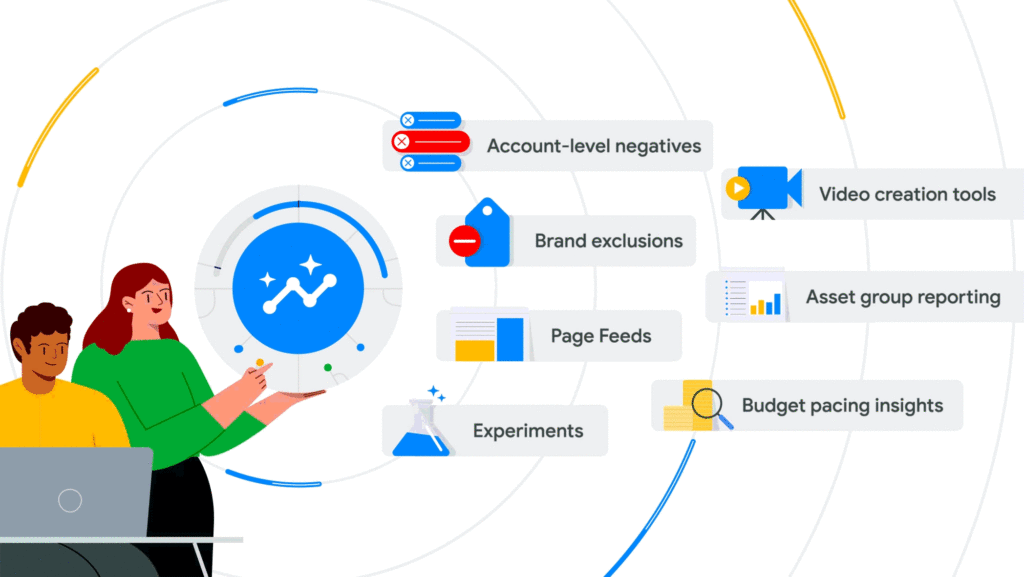Mastering Performance Max: Optimization for Real Results
Understanding Performance Max Campaigns
What are Performance Max campaigns?
Performance Max is a campaign type within Google Ads designed to help advertisers reach their performance objectives across all Google’s mediums including YouTube, Search, Discovery and Maps. It uses Google’s machine learning to optimize your ads in real-time, ensuring they appear to the right audience at the right time.
Key features and benefits
Performance Max campaigns come with several unique features, including asset-based ad creation, cross-network delivery, and real-time optimization. Benefits include a broader reach, simplified campaign management, and access to new audiences. There are also several key ad features such as the Promoted Pins in Google maps that is exclusively only available on performance max campaigns.

Evaluating the Pros and Cons of Performance Max
Advantages of Performance Max campaigns
- Broadened Reach: Access various Google properties like YouTube, Discover, and more.
- Machine Learning: Automated optimization for better targeting and performance.
- Holistic Approach: Unified advertising across multiple Google touchpoints.
- Machine Learning: Adaptive ads using real-time algorithmic insights.
- Flexible Objectives: Tailor campaigns for various marketing goals including foot traffic, sales, or form submissions.
- Automated Bidding: Real-time adjustments for best ad spend value.
- Asset Diversity: Mix of text, images, and videos for varied audience appeal.
- Rich Data Integration: Enhanced targeting with first-party data.
- Simplified Management: Streamlined oversight of unified campaigns.
- Dynamic Adaptation: Campaigns adjust for factors like seasonality.
Disadvantages and limitations Performance Max campaigns
While powerful, PMax campaigns may not fit all business needs. Some limitations include reduced manual control over placements and potential overlap with existing campaigns.
- Lack of Control: Advertisers may find they have limited manual oversight and customization options, especially when compared to traditional Google Ads campaign types.
- Demands Diverse High-Quality Creative Assets: To maximize the campaign’s reach and effectiveness, it’s necessary to provide a variety of quality assets, including videos. This can be resource-intensive for businesses.
- Provides Less Insight: The reporting for Performance Max campaigns might not be as granular as other campaign types. This could lead to challenges in pinpointing specific performance drivers or issues.
- Potential Overlap with Existing Campaigns: There’s a risk of Performance Max campaigns competing with other ad campaigns, causing unnecessary ad spend.
- Dependence on Google’s Algorithm: Relying heavily on Google’s machine learning means advertisers are trusting the platform to make the best decisions, which might not always align with an advertiser’s specific goals.
- Difficulty in Specific Targeting: While Performance Max aims to reach broad audiences efficiently, it might not be ideal for businesses that want to target very niche demographics.

Setting Up Your Performance Max Campaigns for Success
Embrace a holistic advertising approach
While Performance Max campaigns offer a broad reach, it’s essential to incorporate them as a part of a well-rounded digital marketing strategy. By integrating performance max with other campaign types, you can create a harmonious advertising ecosystem, ensuring that every channel reinforces the others, ultimately maximizing visibility and conversions.
Strategically manage keyword exclusions
Overlapping keywords can unintentionally increase competition between your own campaigns, escalating costs and potentially diluting message consistency. By strategically excluding specific keywords in your PMax campaigns, you prevent such overlaps, ensuring that each campaign has its own unique space to shine.
Tailor Performance Max campaigns for distinct objectives
Performance Max campaigns are versatile. Whether you’re introducing a new product line and want to generate awareness or pushing for an end-of-season sale and want to drive conversions, Performance Max can be tailored. By aligning each campaign with a clear objective, you ensure that the machine learning algorithms have a defined target to optimize towards.
Perfect your final URL implementation
The landing page experience is crucial for driving conversions. Ensure that the URLs you associate with your Performance Max campaigns lead to relevant, mobile-optimized, and fast-loading pages. A seamless user experience, from clicking the ad to navigating the landing page, can significantly improve conversion rates.
Integrate audience signals from the outset
Performance Max campaigns thrive on data. By integrating first-party data, like website interactions or CRM data, you provide richer signals for Google’s algorithms. This can result in more personalized ad placements, resonating better with potential customers and leading to improved performance.
The most common and best performing audience signal is to build an audience segment off of the recent buyers on your site.
Monitoring and Reporting on Your Performance Max Campaigns
Keep an eye on keyword overlap and cannibalization
Monitoring your keyword performance across different campaigns can highlight overlaps where multiple campaigns bid for the same keyword. Addressing these overlaps ensures that campaigns don’t drive up costs by competing against each other and that each campaign retains its distinct purpose.
Advanced Optimization Techniques
Implement account-wide negative keywords
Identify and exclude search queries that are not only irrelevant but could lead to unqualified clicks. By maintaining a list of account-wide negative keywords, you streamline your campaigns, ensuring they remain focused on high-potential audiences.
Set up account-level placement exclusions
Not all placements (websites, apps) will align with your brand or yield positive results. By analyzing performance data and excluding low-value placements, you can increase your ads’ overall effectiveness.
Refine targeting by excluding underperforming geolocations
While global reach is a strength of digital marketing, not all regions will resonate with your offer. Analyze geolocation data to identify and exclude or adjust bids for areas with low engagement or conversion rates.
Ensure accurate conversion data integration
A campaign’s optimization is only as good as the data it receives. Regular audits of your conversion tracking setup, ensuring tags are correctly placed and tracking the desired actions, are essential. Reliable data not only informs your current campaigns but also provides insights for future strategies.
We recommend checking your conversions 1-2 times per year at least. If you are constantly improving your site throughout the year or publish a large update to your site all conversions should be tested for accuracy.
Making the Most of Performance Max
Dive deeper: ROAS Bidding & Max Conversion Value Insights
Consider delving into advanced bidding strategies. For instance, ROAS (Target Return on Ad Spend) bidding allows advertisers to focus on campaigns’ return, optimizing for profitability rather than just conversions. This is especially important when you are planning to scale the campaign larger and want to keep you cost per clicks from skyrocketing and running the campaign into unprofitable territory.
Balancing paid and organic search: Avoiding keyword cannibalization
It’s essential to strike a balance between paid ads and organic search results. Regularly review your keyword strategies to ensure that paid campaigns don’t overshadow or compete with your organic rankings. This will make sure you are maximizing visibility without unnecessary ad spend.
You can also use keyword data to provide valuable insights into the keywords and topics that you should write content for on your website.
Optimizing Your Campaign For Specific Goals
Optimizing your App Install Campaigns
If your business has a mobile app, Performance Max can be a potent tool for driving installs. By creating ads optimized for app installs and targeting audiences likely to engage with your app, you can boost not only installation rates but also long-term user engagement.
Optimizing your Campaign for Online Purchases
By ensuring the campaigns are geared towards conversion-centric goals, utilizing high-quality product images, and integrating first-party data for precision targeting, advertisers can effectively drive online purchases. Regularly analyzing the campaign metrics and adjusting based on user behavior and conversion paths can further enhance the return on ad spend and elevate the online shopping experience for users.
Optimizing your Campaign for Local Stores
With the performance max campaign you can target the goal of driving foot traffic to your physical locations making it an amazing ad strategy for any brick and mortar location. To ensure you are building the campaign properly for this goal ensure that you have your Google Business profile setup, and optimized.






